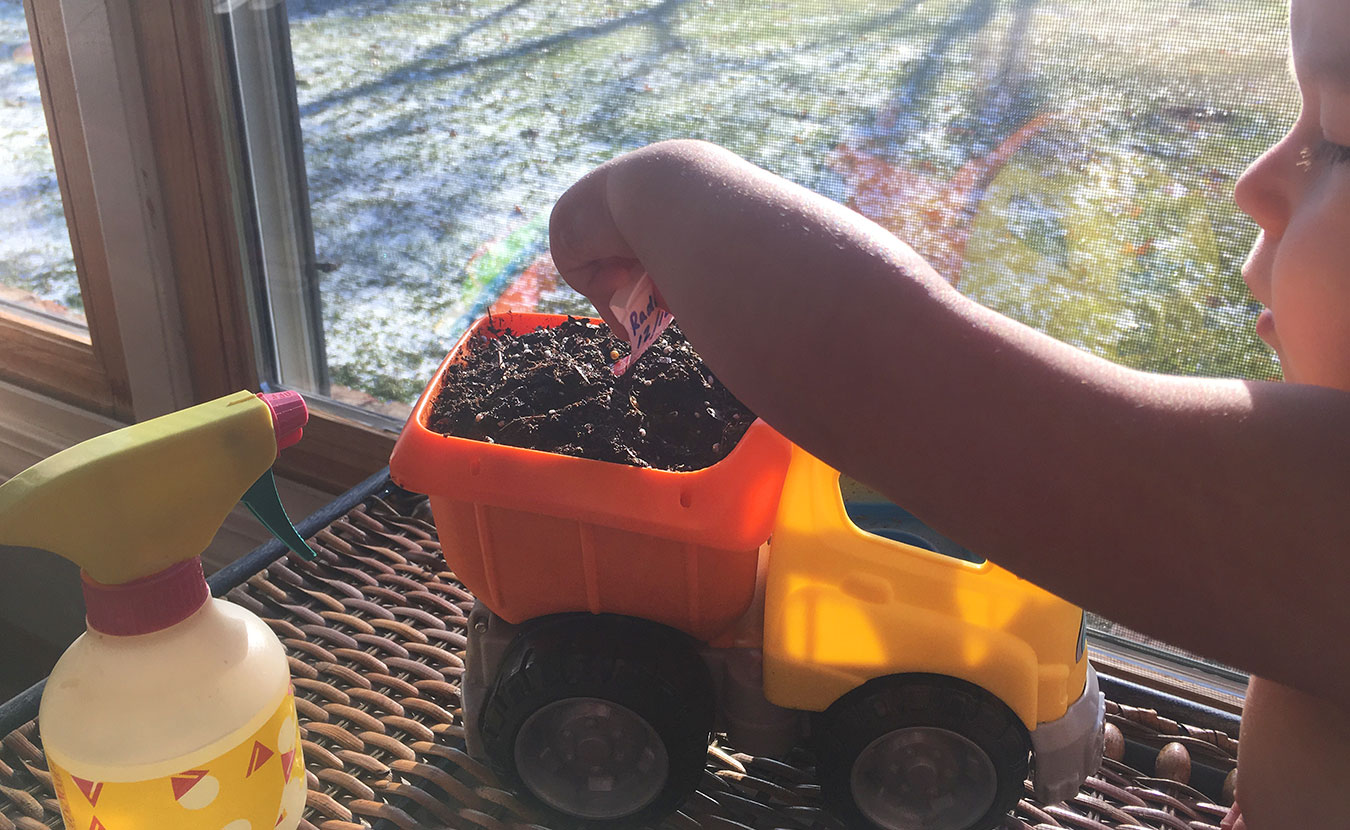A little green stem lifts its head from the soil. Another little head pops up, saying, “Mama, it’s growing!” While we’re used to seeing this scene in June, it can also happen in January — by bringing the garden into our kids’ reach, right in the warmth of our living room.
Summer has plenty of family activities out in the sun — with gardening and hiking being just two ways to earn your bug bites — but when winter comes, we can’t always usher little hands and feet out into the cold. And it’s easy to let screen time edge into more moments of today’s childhood.
Despite this tendency toward screens, Chris Finley, principal of Childs Elementary School in Bloomington, sees a different image of youth. Any day of the week, he sees his students working in the school garden or eagerly composting their food waste in the cafeteria, volunteering away their recess time. “Children are naturally inquisitive about the world around them,” Finley says, “and our garden has had a big impact on the students.” Even in the gloom and gray of winter, we owe the younger generation the right to get their hands dirty.
Bringing it indoors
Winter coupled with an indoor environment might sound like a challenge to most green thumbs, but growing plants indoors is quite feasible, especially in the constant, ideal temperatures of our homes and classrooms. Nevertheless, any gardener will tell you, a question must be asked: “What plants want to grow here?” Gardening is hyper-localized. That’s true whether you’re talking about differences between one vegetation zone to another or from one room to another.

Light is one of the trickiest parts of gardening inside. Make sure you research the types of plants that want to grow in a specific space. | Photo by Katie Posey
The big variable for inside gardening is sunlight. However, don’t believe the naysayers — almost any environment has its eager participants. If you have south- and west-facing windows that bathe in light all day, you will have a wider range of plants to choose from, even tomatoes and peppers. Bush beans could be grown as a houseplant. Otherwise, flowers like calendula and violets are no-fuss and ever-beautiful. Windowsills and sunrooms make for ideal plant sites, but containers can rest on the floor anywhere that gets a little sun. Artificial lighting is always an option to supplement a shady house. And there are plenty of tasty species that will happily do well with less (for example: lettuces, kale, baby spinach, and many of the main culinary herbs).
Humidity can be tricky, and especially so if your furnace is running. The dry air of a heated home may mean checking a couple of times a day on moisture levels of your potted friends. Make sure you use a drainage tray under your plant to avoid water damage from watering your plants inside your home.
Keeping it kid-centered
Here’s the good news for those worrying about their gardening skills: When we garden with our kids, we don’t have to focus on results. It’s a matter of process. It’s the journey — not the size of our cucumbers — that provides them with lifelong learning. So keep expectations light and have fun. By all means, giggle while you garden.
Amy Thompson, a Monroe County extension agent who delivers sound advice to local gardeners and farmers, recommends staying creative to ensure the enthusiasm of students and children. Specifically, she suggests growing sprouts of different kinds of beans, lentils, and other seeds. These grow quickly so you can cycle through varieties constantly to keep the activity fresh for a child. Also, it takes very little space.
Another idea is reincarnating vegetable scraps. Avocado seeds can be started instead of pitched (but you’ll need a greenhouse or a warm, south-facing sunroom to actually get the plant to grow fruit). Green onions can be re-sprouted from discarded roots. Cuttings of herbs can be rooted in water then transplanted into soil.
Use your imagination. Instead of just growing romaine in potting soil, try some less traditional indoor gardening options. See-through, worm-composting bins can be a great activity for kids to maintain. Mushrooms can be grown on logs or from kits. Make a pizza herb garden if your kids like pizza (what kid doesn’t like pizza?). Grow pumpkin seeds in a scooped-out pumpkin, then transplant it all straight into the dirt. Or use the winter for nutrition lessons or garden planning, perhaps with crayons and old wrapping paper. Paint pots to use in the spring. Take old packets of seeds and do germination tests.
The point is: Grow something. Your students or kids will liven up just like the seeds they plant.
Getting youngsters on board
With all the competition for their attention, it may sound intimidating to get a child enthusiastic about one of these projects. However, kids naturally gravitate to the visceral experience of plants and gardening. Your initial approach, though, can make a considerable difference.

Kids don’t have to be outside to become interested in gardening. You can bring the garden inside to them. | Photo by Katie Posey
Ask the children for their ideas. Give them options, especially options that reflect their interests. If they choose what to grow, they’re likelier to take ownership and follow through with the process. Keep it visible and accessible, so they’re likely to keep an eye on it. Buy them their own garden tools, or let them help you cook with the finished crop.
One great idea is to make it look expressly unlike an adult activity. Fill a toy dump truck with potting soil and plant into it. Start seeds in an egg carton. Make labels out of popsicle sticks. Bring a kiddie pool into the sunroom as a playful raised bed. Together, make them their own watering can out of a milk jug. Use fun names. Grow “princess peas” or “magical mint.” There are plenty of imaginative ideas online as well.
As for inspiring kids to get on board, Ginny Roberts of the Indiana Farm to School Network says not to overthink it. She has been creating standards-meeting curriculums that incorporate garden and nutrition education in schools. In this work, Roberts has visited hundreds of classrooms, and the class garden or grow lab is always the first thing the students want to show her.
Shouldn’t gardening be one of the first things we show them?


